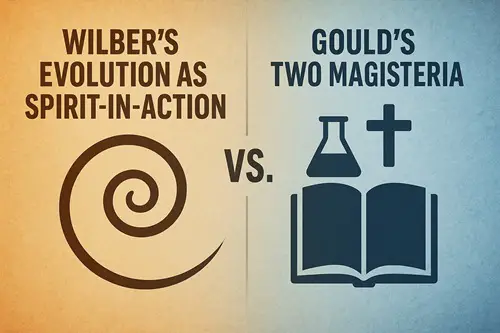|
TRANSLATE THIS ARTICLE
Integral World: Exploring Theories of Everything
An independent forum for a critical discussion of the integral philosophy of Ken Wilber
  Frank Visser, graduated as a psychologist of culture and religion, founded IntegralWorld in 1997. He worked as production manager for various publishing houses and as service manager for various internet companies and lives in Amsterdam. Books: Ken Wilber: Thought as Passion (SUNY, 2003), and The Corona Conspiracy: Combatting Disinformation about the Coronavirus (Kindle, 2020). Frank Visser, graduated as a psychologist of culture and religion, founded IntegralWorld in 1997. He worked as production manager for various publishing houses and as service manager for various internet companies and lives in Amsterdam. Books: Ken Wilber: Thought as Passion (SUNY, 2003), and The Corona Conspiracy: Combatting Disinformation about the Coronavirus (Kindle, 2020).
Check out my other conversations with ChatGPT Marriage or Divorce of Science and Religion?Wilber's Spirit-in-Action vs. Gould's Two MagisteriaFrank Visser / ChatGPT
 IntroductionKen Wilber and Stephen Jay Gould both grapple with the age-old tension between science and religion, evolution and spirit. However, while Gould sought to quarantine the two domains to avoid conflict, Wilber aims to fuse them into a single integrative vision of cosmic unfolding. This essay explores the deep contrasts between Gould's model of Non-Overlapping Magisteria (NOMA) and Wilber's Spirit-in-action view of evolution, revealing two fundamentally incompatible approaches to reconciling science and spirituality. Gould's Two Magisteria: Peace Through SeparationIn his 1997 essay Non-Overlapping Magisteria, evolutionary biologist Stephen Jay Gould proposed a truce between science and religion: each occupies a distinct domain of human understanding. Science explains the empirical universe—how things work, what they're made of, how they evolve. Religion, by contrast, deals with ultimate meaning, moral guidance, and human values. According to Gould, these magisteria do not overlap and should not interfere in each other's business. “Science tries to document the factual character of the natural world, and to develop theories that coordinate and explain these facts. Religion, on the other hand, operates in the equally important, but utterly different, realm of human purposes, meanings, and values.” —Stephen Jay Gould Gould was a staunch Darwinian who rejected any notion of directionality or purpose in evolution. For him, evolution was a contingent, undirected process. His NOMA model was not a metaphysical synthesis but a strategic firewall—a peace treaty to keep religious metaphysics out of science and vice versa. Wilber's Evolution as Spirit-in-Action: A Spiritual TelosIn contrast, Ken Wilber radically collapses the wall that Gould builds. For Wilber, evolution is not a blind, random process but the very movement of Spirit itself: a developmental unfolding toward greater complexity, consciousness, and self-awareness. He calls this “Spirit-in-action,” or the “self-organizing drive of the Kosmos.” “Evolution is best understood not as the random mutation and natural selection of chance occurrences, but as driven by Eros—a deep, spiritual drive toward wholeness, complexity, and depth.” —Ken Wilber This Eros is not a metaphor, nor merely an organizing principle—it is Spirit immanent within matter, nudging atoms toward life, life toward mind, and mind toward higher states of transpersonal awareness. Wilber sees Darwinian mechanisms as partial truths but argues they are insufficient without acknowledging a spiritual telos behind evolutionary emergence. Points of Convergence: A Superficial SimilarityDespite their vastly different metaphysical commitments, both Wilber and Gould share a few superficial traits:
But this is where the similarity ends. Fundamental Divergences
Gould explicitly rejected any teleological interpretations of evolution. For him, the idea that evolution had a purpose or end-goal smacked of pseudoscience. Wilber, in contrast, makes such a teleological drive the centerpiece of his metaphysics. Scientific Credibility: Conflict or Compatibility?From the standpoint of mainstream science, Gould's model is far more acceptable. It preserves methodological naturalism and avoids metaphysical overreach. Wilber's model, though spiritually inspiring for some, crosses the boundary into metaphysical speculation and is not testable or falsifiable in scientific terms. Wilber often criticizes the reductionism of scientific materialism, but he does so by importing spiritual assumptions not grounded in empirical data. For example, he asserts the existence of subtle energies, vital forces, and higher planes—all of which lie outside the scope of scientific validation. Gould, on the other hand, might be faulted for being too modest: by insisting on non-overlap, he prevents potentially meaningful conversations between science and ethics, cosmology and value, or evolution and meaning-making. But his humility preserves science's integrity. Philosophical UnderpinningsGould is an empirical pluralist: he believes that science and religion can coexist as long as they don't make conflicting truth claims. He is a naturalist who avoids metaphysical speculation. His model is a pragmatic solution to institutional and cultural tensions. Wilber is an idealistic synthesist: he aims to integrate all domains of knowledge—science, art, ethics, mysticism—into a single coherent Kosmos. He believes not only in reconciling science and spirituality, but in subsuming science within a broader spiritual framework. Conclusion: Bridge or Firewall?The divide between Wilber and Gould runs deep. One builds bridges, the other erects firewalls. Wilber seeks a grand metaphysical integration where evolution is the self-expression of Spirit. Gould, wary of metaphysical overreach, defends science's domain by keeping religion in a separate lane. Their models offer a revealing contrast: Gould's is cautious, modest, and empirically grounded; Wilber's is bold, sweeping, and spiritually speculative. Whether one finds Wilber's synthesis visionary or overreaching depends on one's comfort with metaphysical idealism. But from the standpoint of scientific rigor, Gould's NOMA remains the more defensible position.
Comment Form is loading comments...
|